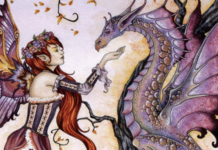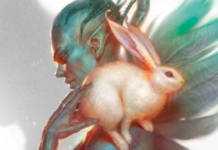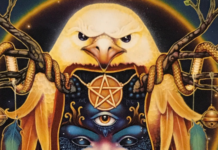
 Alice: The Wonderland Oracle, by Lucy Cavendish, illustrated by Jasmine Becket Griffith
Alice: The Wonderland Oracle, by Lucy Cavendish, illustrated by Jasmine Becket Griffith
Blue Angel Publishing, 9781925538359, 132 pp., 45 cards, 2018
Alice: The Wonderland Oracle is my new favourite deck of cards. Lucy Cavendish puts the oft-puzzling encounters of Lewis Carroll’s heroine into spot-on perspectives about everyday life and our inner adventurer. She writes, “When we are taken on an unexpected adventure we never know exactly what is going to happen to us. That is my experience when I follow the White Rabbit in my life. Without following my curiosity and my heart, I would not be doing this work.”1
The 45 cards in this deck are large, fairytale-size cards measuring 5-7/16 x 3-11/16 inches. They are of medium cardstock thickness, heavier than standard playing cards, but still pliable enough to shuffle. The backs are burgundy with a silvery pattern that resembles scrollwork and are unobtrusive and classy, in contrast to the delightfully colourful and whimsical card faces. The guidebook is just a little larger than the cards at 6-1/4 x 4-1/2 inches. Both come neatly packaged in a sturdy cardboard box that now spends most of its time in my shoulder bag.
The book, at 132 pages, is in itself a fun read. In the introduction, author Lucy Cavendish shares her relationship with Lewis Carroll’s books and the adventurous Alice. She has extraordinary insight into their metaphor — how it relates to the human spirit and imagination — and is able to translate that really well onto the page. She presents alternative methods for shuffling for these oversized cards, several spreads for readings, and finally suggestions on how to care for and get to know the cards. Thereafter follow two-page spreads for each of the 45 cards in the deck. Each is presented with a black-and-white image of the card, a few quick descriptors or clues, followed by a short passage from Alice in Wonderland or its sequel Through the Looking Glass, the author’s thoughts on how that might be relevant to the reader, and finally the summarized keys for divination, both upright and reversed. Each interpretation is surprisingly accurate, often approaching deep matters in a way that is very easy to understand and to apply.
As for the card faces, don’t expect the traditional sketched images that usually come to mind when thinking of Alice in Wonderland. In the Alice: The Wonderland Oracle, each i mage is built around one of Jasmine Becket Griffith’s signature Strangelings: pouty-faced, often teared-up, doe-eyed girls with little button noses. And no two look or read the same. While card seven, “Investigate,” shows a wan girl sitting in a greenish, somewhat dark and scary garden surrounded by thorny plants and strange birds; card 35, “Never Jam Today,” shows a girl literally up to her ears in vibrant pinks and reds and blues, in the form of plump fruits and berries topping all manner of cakes. Card seven urges the seeker to “Look closely, ask questions, think before acting,” but card 35 allows a moment to consider “Promises that never came to be, empty words, not living in the now.”
mage is built around one of Jasmine Becket Griffith’s signature Strangelings: pouty-faced, often teared-up, doe-eyed girls with little button noses. And no two look or read the same. While card seven, “Investigate,” shows a wan girl sitting in a greenish, somewhat dark and scary garden surrounded by thorny plants and strange birds; card 35, “Never Jam Today,” shows a girl literally up to her ears in vibrant pinks and reds and blues, in the form of plump fruits and berries topping all manner of cakes. Card seven urges the seeker to “Look closely, ask questions, think before acting,” but card 35 allows a moment to consider “Promises that never came to be, empty words, not living in the now.”
The majority of the cards are borderless, with a few exceptions. The card numbers and the short little descriptors that begin each card’s section in the book are also printed onto the cards, so there are some bottom or top edges that have semi-opaque color worked in behind the text to set it apart from the artwork.
Alice is my first non-tarot deck. I have always let my vision slide right past oracle decks when looking at the bookstore or online for something interesting and new for my collection. To be frank, I tend to revert to the “more is more” mindset, and oracle decks just don’t have as many cards. They don’t even have a “traditional” number of cards, or a universal pattern that they follow. My left-handed nature wants trumps and pips and court cards. It wants that reliable system with its consistent, even number of 78 cards. Add to that years of simply not getting it when it comes to Lewis Carroll’s stories. I have longed to love the precocious Alice, along with her fantastically-described and illustrated cohorts and their adventures in Wonderland. I have watched movies, read commentaries, and tried repeatedly to read and get enjoyment out of the books. But I have always wound up just thinking Alice should have used more common sense and that Wonderland was possibly a drug-induced creation, and the library got yet another set of books donated to them. But in this fresh new take on Alice, I have finally been shown Wonderland through a vehicle I understand, and yes — I had to go out and buy yet another book. This time, I am reading them aloud to my granddaughters and together we are all little girls off on an adventure.
These cards are decidedly feminine, but they are also ageless, like Alice herself. So far I’ve used them for writing prompts, morning readings, even seek-and-find games with my granddaughters, as well as conversation starters about feelings and choices. Alice: The Wonderland Oracle has been my go-to cards this month for a quick shot of inspiration when I find myself feeling a bit lost. I would recommend them to anyone with a little girl inside them, or one in their lives they want to spend some quality time with.
- p. 8 [↩]








